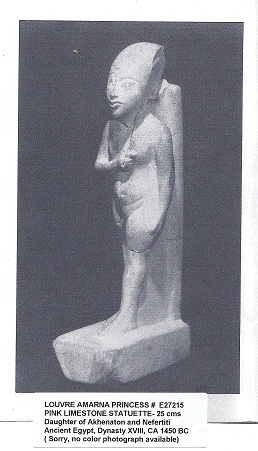THE SAGA OF THE LOUVRE AMARNA PRINCESS
Louvre Artifact # DAE, E 27215
In 1981, the Family of the late M.A. Mansoor, antiquarian in Cairo, Egypt, offered the Louvre Museum a pink limestone
statuette of an Amarna Princess ( XVIII Dynasty – Egypt), in homage to the memory of the late Abbé Etienne Drioton,
a giant of Egyptology. The artifact was accepted on behalf of the Louvre by the late, legendary Egyptologist, Christiane Desroches-Noblecourt.
The artifact was exhibited in the Louvre’s Ancient Egyptian Department during Dr. Desroches-Noblecourt’s
tenure as General Conservator of that department. The artifact was removed from exhibit after her retirement.
Upon enquiring about its removal, in 1997, Dr. Christiane Ziegler, then Conservateur Général, explained in 1999,
(three letters and fourteen months later), that the artifact was removed “faute de place”. A lame explanation,
but understandable, if the intent was to placate us.
Years passed, and the artifact was still unexhibited. We enquired again in 2008, writing Dr. Christophe Barbotin,
then Conservateur en Chef. The letter was forwarded to Madame Guillemmette Andreu-Lanoë, who had succeeded him as
Conservateur Général. Her response was a shocker. She wrote that she and the other conservators of the Ancient Egyptian
Department were of the opinion that the artifact was a “fake”, without giving any objective reason.
An extensive, three year correspondence followed, in which we asked for the return of the artifact,
since they no longer believed in its authenticity. Involved were: other than Madame Andreu-Lanoë, Monsieur Henri Loyrette,
President and Director of the Louvre Museum; Monsieur Pierre Vimont, France’s Ambassador in Washington; Monsieur Bruno Laurioux,
Interim Director, Human and Social Sciences, CNRS, (France’s Centre National de la Recherche Scientifique) and
Monsieur Frédéric Mitterrand, France’s Ministre de la Culture et de la Communication.
A certain Monsieur Philippe Bélaval, “directeur général des patrimoines” , appointed by Monsieur Mitterrand to investigate this matter,
was a “silent” participant, in that he never acknowledged or responded to our mail or taken any action to resolve this matter.
One wonders if he really exists?
This matter has been pending since December 1997, and no end is in the sight. If the Louvre is not convinced of the authenticity
of the artifact, why don’t they want to return it to us? Their response, to our request for the return of the artifact, was that there
is no specific agreement obligating the Louvre to “exhibit” the artifact or return it. If this is so, they are setting a dangerous
precedent, which might haunt them, and other museums, later, since no donor would gift an artifact to a museum and see it relegated
to a basement room at the whim of any conservator.
Frankly, we consider the artifact to be in hostile hands and we would much rather have it in our possession,
where it would be much safer.
Logic would dictate that if the artifact is a “faux” as claimed by Madame Andreu-Lanoë, why has the directeur
du Patrimoine refused to return it. Why keep a “faux” in the National Heritage ? That fact, alone, should tell
you that there is foul play and the administration of the Louvre is part of a dangerous cabal.
This matter, unresolved since 1997(!), is nothing but the result of petty politics. The Louvre’s Ancient Egyptian department management
would rather listen to the diktat of a certain Dietrich Wildung, of Germany, “a self proclaimed leader” of a mafia, than to its
own scientists and some of their most respected scholars.
http://www.mansooramarnacollection.com/correspondence/itsamafia.shtml
In her last – and only - letter to us, since August 2008 ( this one prompted by Monsieur Mitterrand), Madame Andreu-Lanoë
stated that the artifact is considered a “faux” by “la communauté scientifique”. A challenge has been sent to her,
asking her to produce a statement from the “communauté scientifique” to that effect, contradicting the reports by the
Laboratoires des Musées Nationaux, which authenticated the artifact 1981, and the CNRS. We are still waiting, but not holding our breath!
Please visit www.mansooramarnacollection.com to view the entire correspondence.
We are glad to supply any reader with a copy of any letter or document mentioned in the correspondence and which we
may have omitted to include here. Please request from al@mansoor.name
Thank you for your interest in the Mansoor Amarna Collection.
Notes regarding the artifact:
The artifact is a very rare statue of a Princess, daughter of Akhenaton and Nefertiti (XVIIIth Dynasty, Egypt, ca 1450 BC) and is part of a collection of Tell El Amarna art originally consisting of 106 artifacts, most of which are the property of private collectors in Europe and the United States and, at least three, museums. It is carved of pink limestone, which was rarely, but occasionally, used in Ancient Egypt. The artifact is 25cms. high(10 inches).It was broken in four pieces-at an undetermined date- and “ repaired”, also, at an undetermined date, by parties unknown. When the late Dr. Desroches- Noblecourt was contemplating the acquisition of the artifact for the Louvre, she asked for permission to have the Louvre’s technician, take the statue apart, for , as she wrote:
“….je voudrais avoir réuni tous les éléments qui me permettraient de la présenter au premier comité des Conservateurs du mois d’octobre.
Cependant, cela ne serait possible sans l’avoir complètement étudiée, c’est-à-dire sans avoir pu faire décoller au moins la tête……”
( her letter of August 10,1981, included). Of course, permission was granted and the artifact was inducted in the
“”cénacle”des représentations de l’art et de la civilization du départment intéressé”.( From Dr. Desroches-Noblecourt’s “
La Grande Nubiade’, page 352, copy of text included)
“it is amazing, how the same strong passion which makes some create great works of art, makes others want to destroy them”. Author unknown.
|



